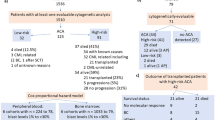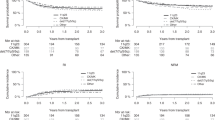Abstract
The instability of the karyotype may play a role in the development of refractoriness of acute myeloid leukemia (AML) to anti-leukemic therapy. Therefore, in the current study cytogenetic analyses were performed in 117 patients with AML both at diagnosis and at relapse. Changes in karyotype were observed in 38% (36% of initially normal karyotypes, 39% of initially aberrant karyotypes). An evolution of karyotype, ie the acquisition of further aberrations in addition to those present at diagnosis, occurred more frequently in patients with unfavorable karyotypes at diagnosis as compared to all others (60% vs 32%, P = 0.0095). The duration from initial diagnosis to relapse was significantly shorter in cases with an evolution of the aberrant karyotype as compared to cases with no changes in the aberrant karyotype between diagnosis and relapse or with solely regression of aberrations at relapse (9.2 ± 4.4 vs14.0 ± 8.5 months, P = 0.0081). In an additional analysis, another cohort of 120 patients with refractory and relapsed AML who were treated uniformly within the respective trial of the German AML Cooperative Group was analyzed cytogenetically at diagnosis and at relapse to further prove the prognostic impact of karyotype aberrations at relapse. Karyotypes were prognostically favorable, intermediate, unfavorable and not available in 8%, 50%, 17% and 25% at diagnosis and in 8%, 49%, 21% and 22% at relapse, respectively. Karyotype aberrations at diagnosis had no impact on response to therapy (P = 0.32) but influenced survival and event-free survival significantly (P = 0.03 and P = 0.02). In contrast, karyotype aberrations at relapse strongly influenced response to therapy (P = 0.05), survival (P = 0.01), and event-free survival (P = 0.002). These data suggest that the instability of the karyotype between diagnosis and relapse and thus karyotype aberrations at relapse in particular contribute to the refractoriness of AML to anti-leukemic therapy.
This is a preview of subscription content, access via your institution
Access options
Subscribe to this journal
Receive 12 print issues and online access
$259.00 per year
only $21.58 per issue
Buy this article
- Purchase on Springer Link
- Instant access to full article PDF
Prices may be subject to local taxes which are calculated during checkout





Similar content being viewed by others
References
Rowley JD . Molecular genetics in acute leukemia Leukemia 2000 14: 513–517
Melnick A, Licht JD . Deconstructing a disease: RARalpha, its fusion partners, and their roles in the pathogenesis of acute promyelocytic leukemia Blood 1999 93: 3167–3215
Downing JR . The AML1-ETO chimaeric transcription factor in acute myeloid leukaemia: biology and clinical significance Br J Haematol 1999 106: 296–308
Goger M, Gupta V, Kim WY, Shigesada K, Ito Y, Werner MH . Molecular insights into PEBP2/CBF beta-SMMHC associated acute leukemia revealed from the structure of PEBP2/CBF beta Nat Struct Biol 1999 6: 620–623
Schoch C, Haferlach T, Haase D, Fonatsch C, Loffler H, Schlegelberger B, Staib P, Sauerland MC, Heinecke A, Buchner T, Hiddemann W . Patients with de novo acute myeloid leukaemia and complex karyotype aberrations show a poor prognosis despite intensive treatment: a study of 90 patients Br J Haematol 2001 112: 118–126
Buchner T, Hiddemann W, Wormann B, Loffler H, Gassmann W, Haferlach T, Fonatsch C, Haase D, Schoch C, Hossfeld D, Lengfelder E, Aul C, Heyll A, Maschmeyer G, Ludwig WD, Sauerland MC, Heinecke A . Double induction strategy for acute myeloid leukemia: the effect of high-dose cytarabine with mitoxantrone instead of standard-dose cytarabine with daunorubicin and 6-thioguanine: a randomized trial by the German AML Cooperative Group Blood 1999 93: 4116–4124
Grimwade D, Walker H, Oliver F, Wheatley K, Harrison C, Harrison G, Rees J, Hann I, Stevens R, Burnett A, Goldstone A . The importance of diagnostic cytogenetics on outcome in AML: analysis of 1,612 patients entered into the MRC AML 10 trial. The Medical Research Council Adult and Children's Leukaemia Working Parties Blood 1998 92: 2322–2333
Kern W, Schoch C, Haferlach T, Braess J, Unterhalt M, Wormann B, Buchner T, Hiddemann W . Multivariate analysis of prognostic factors in patients with refractory and relapsed acute myeloid leukemia undergoing sequential high-dose cytosine arabinoside and mitoxantrone (S-HAM) salvage therapy: relevance of cytogenetic abnormalities Leukemia 2000 14: 226–231
Gale RP, Horowitz MM, Weiner RS, Ash RC, Atkinson K, Babu R, Dicke KA, Klein JP, Lowenberg B, Reiffers J . Impact of cytogenetic abnormalities on outcome of bone marrow transplants in acute myelogenous leukemia in first remission Bone Marrow Transplant 1995 16: 203–208
Schneider E, Cowan KH, Bader H, Toomey S, Schwartz GN, Karp JE, Burke PJ, Kaufmann SH . Increased expression of the multidrug resistance-associated protein gene in relapsed acute leukemia Blood 1995 85: 186–193
Bennett JM, Catovsky D, Daniel MT, Flandrin G, Galton DA, Gralnick HR, Sultan C . Proposal for the recognition of minimally differentiated acute myeloid leukaemia (AML-MO) (see comments) Br J Haematol 1991 78: 325–329
Bennett JM, Catovsky D, Daniel MT, Flandrin G, Galton DA, Gralnick HR, Sultan C . Proposed revised criteria for the classification of acute myeloid leukemia. A report of the French–American–British Cooperative Group Ann Intern Med 1985 103: 620–625
Bennett JM, Catovsky D, Daniel MT, Flandrin G, Galton DA, Gralnick HR, Sultan C . A variant form of hypergranular promyelocytic leukemia (M3) (letter) Ann Intern Med 1980 92: 261
Bennett JM, Catovsky D, Daniel MT, Flandrin G, Galton DA, Gralnick HR, Sultan C . Proposals for the classification of the acute leukaemias. French– American–British (FAB) co-operative group Br J Haematol 1976 33: 451–458
Kern W, Schoch C, Haferlach T, Braess J, Wormann B, Buchner T, Ludwig WD, Hiddemann W . Prognostic significance of cytogenetics at relapse in patients receiving sequential high-dose cytosine arabinoside and idarubicin (S-HAI) + fludarabine therapy for refractory and relapsed acute myeloid leukemia Blood 2000 96: 504a
Kern W, Aul C, Maschmeyer G, Schönrock-Nabulsi R, Ludwig WD, Bartholomaus A, Bettelheim P, Wormann B, Buchner T, Hiddemann W for the German AML Cooperative Group. Superiority of high-dose over intermediate-dose cytosine arabinoside in the treatment of patients with high-risk acute myeloid leukemia: results of a age-adjusted prospective randomized comparison Leukemia 1998 12: 1049–1055
Schoch C, Bursch S, Kern W, Schnittger S, Hiddemann W, Haferlach T . Gain of an isochromosome 5p: a new recurrent chromosome abnormality in acute monoblastic leukemia Cancer Genet Cytogenet 2001 127: 85–88
Schnittger S, Schoch C, Kern W, Staib P, Wuchter C, Sauerland C, Serve H, Buchner T, Haferlach T, Hiddemann W . FLT3 length mutations in AML: correlation to cytogenetics, FAB-subtype, and prognosis in 652 patients Blood 2000 96: 826a
Schnittger S, Wormann B, Hiddemann W, Griesinger F . Partial tandem duplications of the MLL gene are detectable in peripheral blood and bone marrow of nearly all healthy donors Blood 1998 92: 1728–1734
Buchner T, Hiddemann W, Wormann B et al. Threapeutic outcome in AML is mainly determined by cytogenetics, LDH in serum, early response and, in a poor risk subgroup, by intensified induction treatment Blood 1997 90 (Suppl. 1): 504a
Schoch C, Haase D, Haferlach T, Gudat H, Buchner T, Freund M, Link H, Lengfelder E, Wandt H, Sauerland MC, Loffler H, Fonatsch C . Fifty-one patients with acute myeloid leukemia and translocation t(8;21)(q22;q22): an additional deletion in 9q is an adverse prognostic factor Leukemia 1996 10: 1288–1295
Schoch C, Haase D, Haferlach T, Freund M, Link H, Lengfelder E, Loffler H, Buchner T, Fonatsch C . Incidence and implication of additional chromosome aberrations in acute promyelocytic leukaemia with translocation t(15;17)(q22; q21): a report on 50 patients Br J Haematol 1996 94: 493–500
Schoch C, Haase D, Fonatsch C, Haferlach T, Loffler H, Schlegelberger B, Hossfeld DK, Becher R, Sauerland MC, Heinecke A, Wormann B, Buchner T, Hiddemann W . The significance of trisomy 8 in de novo acute myeloid leukaemia: the accompanying chromosome aberrations determine the prognosis. German AML Cooperative Study Group Br J Haematol 1997 99: 605–611
Yates J, Glidewell O, Wiernik P, Cooper MR, Steinberg D, Dosik H, Levy R, Hoagland C, Henry P, Gottlieb A, Cornell C, Berenberg J, Hutchison JL, Raich P, Nissen N, Ellison RR, Frelick R, James GW, Falkson G, Silver RT, Haurani F, Green M, Henderson E, Leone L, Holland JF . Cytosine arabinoside with daunorubicin or adriamycin for therapy of acute myelocytic leukemia: a CALGB study Blood 1982 60: 454–462
Rowley JD, Potter D . Chromosomal banding patterns in acute nonlymphocytic leukemia Blood 1976 47: 705–721
Li YS, Khalid G, Hayhoe FG . Correlation between chromosomal pattern, cytological subtypes, response to therapy, and survival in acute myeloid leukaemia Scand J Haematol 1983 30: 265–277
Estey E, Keating MJ, Pierce S, Stass S . Change in karyotype between diagnosis and first relapse in acute myelogenous leukemia Leukemia 1995 9: 972–976
Garson OM, Hagemeijer A, Sakurai M, Reeves BR, Swansbury GJ, Williams GJ, Alimena G, Arthur DC, Berger R, de la Chapelle A . Cytogenetic studies of 103 patients with acute myelogenous leukemia in relapse Cancer Genet Cytogenet 1989 40: 187–202
Testa JR, Mintz U, Rowley JD, Vardiman JW, Golomb HM . Evolution of karyotypes in acute nonlymphocytic leukemia Cancer Res 1979 39: 3619–3627
Kantarjian HM, Keating MJ, Walters RS, McCredie KB, Freireich EJ . The characteristics and outcome of patients with late relapse acute myelogenous leukemia J Clin Oncol 1988 6: 232–238
Author information
Authors and Affiliations
Rights and permissions
About this article
Cite this article
Kern, W., Haferlach, T., Schnittger, S. et al. Karyotype instability between diagnosis and relapse in 117 patients with acute myeloid leukemia: implications for resistance against therapy. Leukemia 16, 2084–2091 (2002). https://doi.org/10.1038/sj.leu.2402654
Received:
Accepted:
Published:
Issue Date:
DOI: https://doi.org/10.1038/sj.leu.2402654
Keywords
This article is cited by
-
Cytogenetic evolution predicts a poor prognosis in acute myeloid leukemia patients who relapse after allogeneic hematopoietic stem cell transplantation
Annals of Hematology (2023)
-
Prognostic impact of chromosomal changes at relapse after allogeneic hematopoietic cell transplantation for acute myeloid leukemia or myelodysplastic syndrome
Bone Marrow Transplantation (2022)
-
Genomic and evolutionary portraits of disease relapse in acute myeloid leukemia
Leukemia (2021)
-
Emerging agents and regimens for treatment of relapsed and refractory acute myeloid leukemia
Cancer Gene Therapy (2020)
-
Salvage regimens using conventional chemotherapy agents for relapsed/refractory adult AML patients: a systematic literature review
Annals of Hematology (2018)



